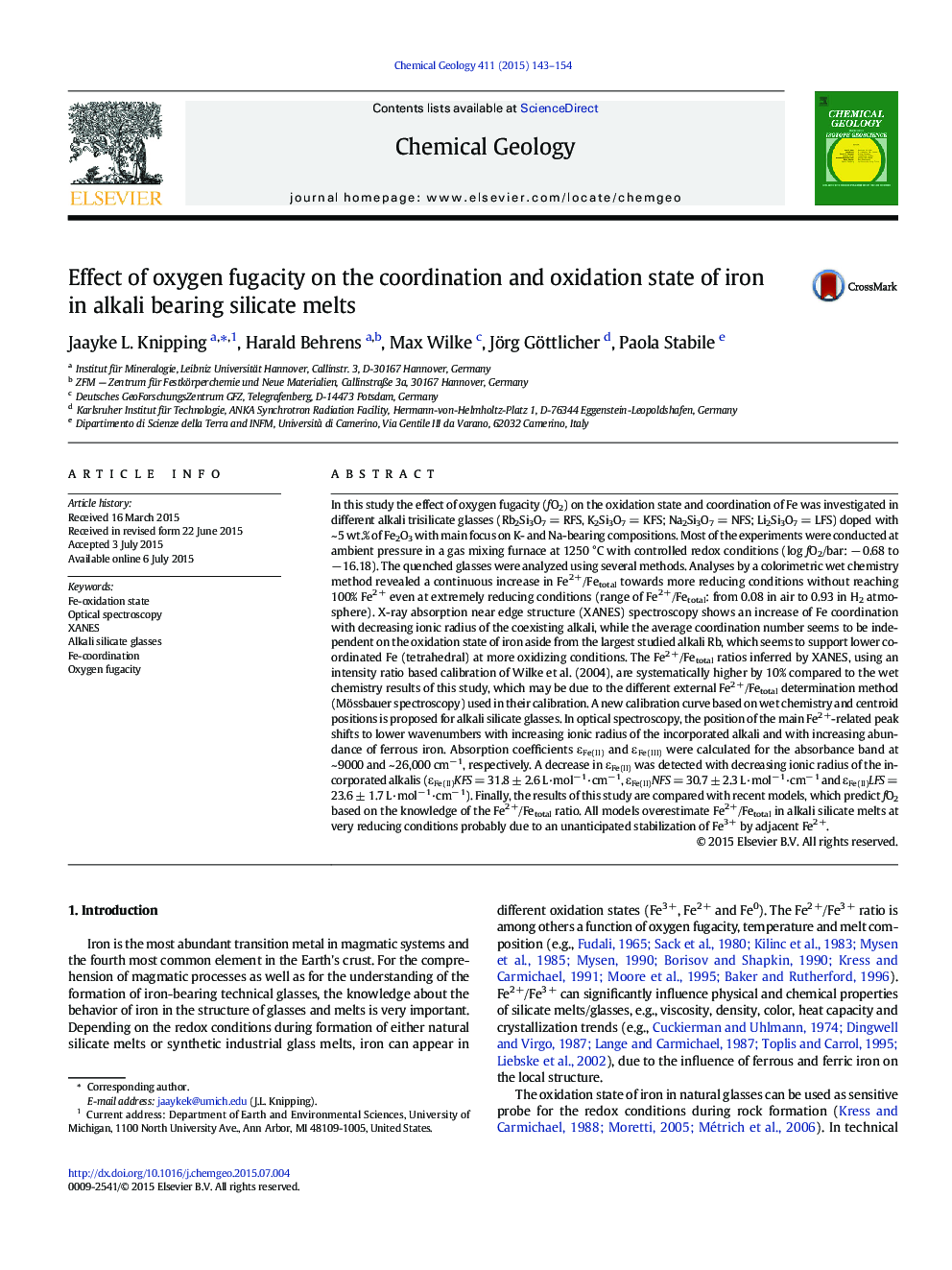| کد مقاله | کد نشریه | سال انتشار | مقاله انگلیسی | نسخه تمام متن |
|---|---|---|---|---|
| 6436324 | 1637563 | 2015 | 12 صفحه PDF | دانلود رایگان |
- Increasing alkali radius and Fe2Â + concentration shift the Fe2Â +-related peak in optical spectroscopy to lower wavenumbers.
- Absorption coefficients were calculated for Fe2 + (~ 9000 cmâ 1) and Fe3 + (~ 26,000 cmâ 1) in optical spectroscopy.
- A new XANES calibration curve based on wet chemistry and centroid positions is proposed for alkali silicate glasses.
- fO2 predicting models overestimate Fe2Â +/Fetotal in alkali silicate melts at very reducing conditions.
- Stabilization of Fe3Â + by adjacent Fe2Â + may explain the detected non-ideal mixing between Fe3Â + and Fe2Â + at Fe2Â + >Â 75%.
In this study the effect of oxygen fugacity (fO2) on the oxidation state and coordination of Fe was investigated in different alkali trisilicate glasses (Rb2Si3O7 = RFS, K2Si3O7 = KFS; Na2Si3O7 = NFS; Li2Si3O7 = LFS) doped with ~ 5 wt.% of Fe2O3 with main focus on K- and Na-bearing compositions. Most of the experiments were conducted at ambient pressure in a gas mixing furnace at 1250 °C with controlled redox conditions (log fO2/bar: â 0.68 to â 16.18). The quenched glasses were analyzed using several methods. Analyses by a colorimetric wet chemistry method revealed a continuous increase in Fe2 +/Fetotal towards more reducing conditions without reaching 100% Fe2 + even at extremely reducing conditions (range of Fe2 +/Fetotal: from 0.08 in air to 0.93 in H2 atmosphere). X-ray absorption near edge structure (XANES) spectroscopy shows an increase of Fe coordination with decreasing ionic radius of the coexisting alkali, while the average coordination number seems to be independent on the oxidation state of iron aside from the largest studied alkali Rb, which seems to support lower coordinated Fe (tetrahedral) at more oxidizing conditions. The Fe2 +/Fetotal ratios inferred by XANES, using an intensity ratio based calibration of Wilke et al. (2004), are systematically higher by 10% compared to the wet chemistry results of this study, which may be due to the different external Fe2 +/Fetotal determination method (Mössbauer spectroscopy) used in their calibration. A new calibration curve based on wet chemistry and centroid positions is proposed for alkali silicate glasses. In optical spectroscopy, the position of the main Fe2 +-related peak shifts to lower wavenumbers with increasing ionic radius of the incorporated alkali and with increasing abundance of ferrous iron. Absorption coefficients εFe(II) and εFe(III) were calculated for the absorbance band at ~ 9000 and ~ 26,000 cmâ 1, respectively. A decrease in εFe(II) was detected with decreasing ionic radius of the incorporated alkalis (εFe(II)KFS = 31.8 ± 2.6 L·molâ 1·cmâ 1, εFe(II)NFS = 30.7 ± 2.3 L·molâ 1·cmâ 1 and εFe(II)LFS = 23.6 ± 1.7 L·molâ 1·cmâ 1). Finally, the results of this study are compared with recent models, which predict fO2 based on the knowledge of the Fe2 +/Fetotal ratio. All models overestimate Fe2 +/Fetotal in alkali silicate melts at very reducing conditions probably due to an unanticipated stabilization of Fe3 + by adjacent Fe2 +.
Journal: Chemical Geology - Volume 411, 14 September 2015, Pages 143-154
